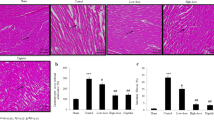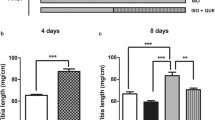Abstract
Recent reports on the involvement of calcineurin in cardiac hypertrophy and its susceptibility to free radicals, prompted us to examine possible beneficial effects of dietary antioxidants in this regard. In continuation of initialin vitro studies revealing eugenol to be a potent calcineurin inhibitor, we investigated its ability to reverse isoproterenol-induced cardiac hypertrophy in rats. Intraperitoneal administration of isoproterenol (1 mg/kg body wt/day for 10 days) induced cardiac hypertrophy with increased heart weight and enhanced apoptosis of myocytes concomitant with accumulation of reactive oxygen species, decreased glutathione contents, increased activities of calcineurin and protein kinase C in ventricular tissue. Administering eugenol for 3 days (1 mg/kg body wt/twice a day), followed by combined administration of isoproterenol and eugenol resulted in significant reversal of cardiac hypertrophy and restoration of above changes. These results suggest that eugenol, a natural antioxidant of dietary origin, may offer potential benefits in the management of cardiac hypertrophy.
Similar content being viewed by others
References
Braun, M., Simonis, G., Birkner, K., Pauke, B. and Strasser, R.H. (2003) Regulation of protein kinase C isozyme and calcineurin expression in isoproterenol induced cardiac hypertrophy. J. Cardiovasc. Pharmacol. 41, 946–954.
Cao, Z., Tsang, M., Zhao, H. and Li, Y (2003) Induction of endogenous antioxidants and phase 2 enzymes by a-lipoic acid in rat cardiac H9C2 cells: protection against oxidative injury. Biochem. Biophys. Res. Commun. 310, 979–985.
Chattopadhyay, A., Biswas, S., Bandyopadhyay, D., Sarkar, C. and Datta, A. G. (2003) Effect of isoproterenol on lipid peroxidation and antioxidant enzymes of myocardial tissue of mice and protection by quinidine. Mol. Cell. Biochem. 245, 43–49.
FAO (1982) Evaluation of certain food additives and contaminants. Technical Report Series No. 20. FAO/WHO Expert Committee on food additives.
Hissin, P.J. and Hilf, R (1976) A fluorimetric method for determination of oxidized and reduced glutathione in tissues. Anal. Biochem. 74, 214–226.
Huang, Y.C., Wu, B.N., Lin, Y.T., Chen, S.J., Chiu, C.C., Cheng, C.J. and Chen, I.J. (1999) Eugenodilol: a third-generation beta-adrenoceptor blocker, derived from eugenol, with alpha-adrenoceptor blocking and beta2-adrenoceptor agonist-associated vasorelaxant activities. J. Cardiovasc. Pharmacol. 34, 10–20.
Jayashree, T. and Subramanyam, C. (1999) Antiaflatoxigenic activity of eugenol is due to inhibition of lipid peroxidation. Lett. Appl Microbiol. 28, 179–183.
Kang, Y.J., Zhou, Z.X., Wu, H., Wang, G.W., Saari, J.T. and Klein, J.B. (2000) Metallothionein inhibits myocardial apoptosis in copper-deficient mice: role of atrial natriuretic peptide. Lab. Invest. 80, 745–757.
Leinwand, L.A. (2001) Calcineurin inhibition and cardiac hypertrophy: A matter of balance. Proc. Natl. Acad. Sci. USA. 98, 2947–2949.
Lin, Y.T., Wu, B.N., Horng, C.F., Huang, Y.C., Hong, S.J., Lo, Y.C., Cheng, C.J. and Chen, I.J. (1999) Isoeugenolol: A selective beta 1-drenergic antagonist with tracheal and vascular smooth muscle relaxant properties. Jpn. J. Pharmacol. 80, 127–136.
Lipkin, G.W., Tucker, B., Giles, M. and Raine, A.E. (1993) Ambulatory blood pressure and left ventricular mass in cyclosporin and not cyclosporin treated renal transplant recipients. J. Hypertens. 11, 439–442.
Marklund, S. and Marklund, G. (1974) Involvement of the superoxide anion radical in the auto oxidation of pyrogallol and a convenient assay for superoxide dismutase. Eur. J. Biochem. 47, 469–474.
Martinez, J.I.R., Launay, J.M. and Dreux, C (1979) A sensitive flourimetric microassay for glutathione peroxidase activity. Application to human blood platelets. Anal. Biochem. 98, 154–159.
Meguro, T., Hong, C., Asai, K., Takagi, G., McKinsey, T.A., Olson, E.N. and Vatner, S.F. (1999) Cyclosporine attenuates pressure overload hypertrophy in mice while enhancing susceptibility to decompensation and heart failure. Circ. Res. 84, 735–740.
Miyashita, T., Takeishi, Y., Takahashi, H., Kato, S., Kubota, I. and Tomoike, H. (2001) Role of calcineurin in insulin-like growth factor-1-induced hypertrophy of cultured adult rat ventricular myocytes. Jpn. Circ. J. 65, 815–819.
Molkentin, J., Lu, J., Antos, C., Markham, B., Richardson, J., Robbins, J., Grant, S. and Olson, E.N. (1998) A calcineurin dependent transcriptional pathway for cardiac hypertrophy. Cell. 93, 215–228.
Molkentin, J.D. (2000) Calcineurin and beyond: Cardiac hypertrophy signaling. Circ. Res. 87, 731–738.
Nagata, K., Somura, F., Obata, K., Odashima, M., Izawa, H., Ichihara, S., Nagasaka, T., Iwase, M., Yamada, Y., Nakashima, N. and Yokota, M. (2002) AT1 receptor blockade reduces cardiac calcineurin activity in hypertensive rats. Hypertension. 40, 168–74.
Padma, S. and Subramanyam, C. (1999) Extracellular calcineurin: Identification and quantitation in serum and amniotic fluid. Clin. Biochem. 32, 491–494.
Pandey, B.N. and Mishra, K.P. (2003) Modification of thymocytes membrane radio-oxidative damage and apoptosis by eugenol. J. Environ. Pathol. Toxicol. Oncol. in Press;
Saccani, S., Saccani, A., Varesio, L., Ghosh, P., Young, H.A. and Sica, A. (1999) Divergent effects of dithiocarbamates on AP-1-containing and AP-1-less NFAT sites. Eur. J. Immunol. 29, 1194–1201.
Sawyer, D.B., Siwik, D.A., Xiao, L., Pimentel, D.R., Singh, K. and Colucci, W.S. (2002) Role of oxidative stress in myocardial hypertrophy and failure. J. Mol. Cell. Cardiol. 34, 379 {INCLUDEPICTURE “http://www.pubmedcentral.nih.gov/corehtml/pmc/pmcents/ndash.gif”/*MERGEFORMATINET}388.
Sharma, J.N., Srivastava, K.C. and Gan, E.K. (1994) Suppressive effects of eugenol and ginger oil on arthritic rats. Pharmacology. 49, 314–318.
Shizukuda, Y., Buttrick, P.M., Geenen, D.L., Borczuk, A.C., Kitsis, R.N. and Sonnenblick, E.H. (1998) beta-adrenergic stimulation causes cardiocyte apoptosis: influence of tachycardia and hypertrophy. Am. J. Physiol. 275, H961-H968.
Snedecor, G.W. and Cochran, W.G. (1986) Shortcut and non-parametric methods. In: Statistical methods, Eds. Snedecor, G.W. and Cochran, W.G., Oxford and IBH, New Delhi, 120–132.
Sugden, P.H. (2001) Signalling pathways in cardiac myocyte hypertrophy. Ann. Med. 33, 611–622.
Terzian, A.R. and Rubin, R.P. (1993) Translocation of the á-isozyme of protein kinase C during stimulation of rat parotid acinar cells by phorbol ester and carbachol. Archives. Oral. Biol. 38, 1051–1056.
Wang, X., Culotta, V.C. and Klee, C.B. (1996) Superoxide dismutase protects calcineurin from inactivation. Nature. 383, 434–437.
Zou, Y., Yao, A., Zhu, W., Kudoh, S., Hiroi, Y., Shimoyama, M., Uozumi, H., Kohmoto, O., Takahashi, T., Shibasaki, F., Nagai, R., Yazaki, Y. and Komuro, I (2001) Isoproterenol activates extracellular signal-regulated protein kinases in cardiomyocytes through calcineurin. Circulation. 104, 102–108.
Author information
Authors and Affiliations
Corresponding author
Rights and permissions
About this article
Cite this article
Choudhary, R., Mishra, K.P. & Subramanyam, C. Prevention of isoproterenol-induced cardiac hypertrophy by eugenol, an antioxidant. Indian J Clin Biochem 21, 107–113 (2006). https://doi.org/10.1007/BF02912923
Issue Date:
DOI: https://doi.org/10.1007/BF02912923




